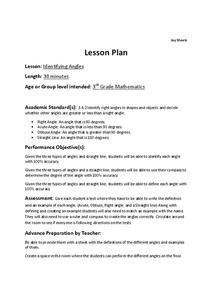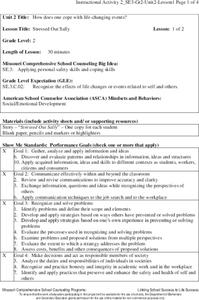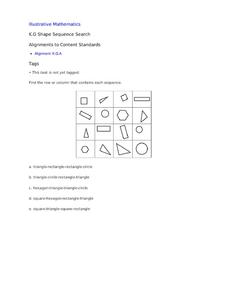Chemistry Collective
Virtual Lab: Identifying an Unknown Liquid from its Density
Mislabeled bottles can cause a dangerous situation! Young chemists design a method for determining the true contents of a solution in a virtual lab activity. Their study of density helps them identify the makeup of the solution.
Curated OER
Identify Genre, Subgenre, and Author's Purpose
Explore genre, subgenre, and author's purpose in this helpful worksheet. Middle schoolers read several summaries of books and short stories, and identify the genre and subgenre. They also determine if the author's purpose is to...
Curated OER
Identifying Text Structure
Work on identifying text structure with this thorough worksheet. After studying a diagram depicting six different text structures (compare/contrast, spatial, chronological, problem and solution, cause and effect, and order of...
Curated OER
Identifying Personification in Poetry
Improve your young poets' descriptive writing with this lesson on personification. A SMART board and PowerPoint presentation guide your class through the process of identifying human qualities attributed to various non-human objects. A...
Curated OER
Identifying Coins and Their Value
Use the special Tennessee State Quarter as a learning tool. During this lesson, discuss why the Tennessee Quarter has musical instruments on it. You can also utilize a worksheet embedded in the plan to help your class compose a song that...
Curated OER
Identifying and Generating Rhyming Words, Body
Can you tell which words rhyme? Choose a body part as a starting word (i.e. head) and begin saying words to see if learners can identify those that rhyme. Does red rhyme with head? Continue giving examples, some...
Curated OER
Identifying Irony
What are the three types of irony? After reviewing dramatic, situational, and verbal irony with your readers, present them with this two-page document. They read six excerpts to determine which type of irony is used in each. After...
Charleston School District
Identifying Irrational Numbers
These numbers have some personality! Are they rational or irrational? The lesson examines the definitions of rational and irrational numbers and shows examples of how to identify them.
US Institute of Peace
Identifying Conflict Styles
Are you a peace-keeper or a problem-solver? Explore conflict management styles through a lesson, fourth in a 15-part series, that combines individual assessment and collaborative work. Groups learn the basic tendencies of each style,...
Curated OER
Identifying Fractions (1 of 6)
In this identifying fractions worksheet, students examine 11 pictures, record the fraction shown, and write the words that represent the fractions.
Alabama Learning Exchange
The Birth of Rock(s) - Identifying Rock Types
Young scientists investigate types of rocks in this instructional activity. They collaborate to examine groups of rocks, make written descriptions of them, and use websites to help them identify the types of rocks they are.
Curated OER
Identifying Angles
Third graders analyze angles and determine if they are acute, right, or obtuse. In this angles lesson, 3rd graders study the definition and characteristics of each angle. Students then do a worksheet to identify the name of the angle.
Curated OER
Identifying Narrative Perspective 4
For this narrative perspective worksheet, students identify the narrative perspective of paragraphs read including first, second, third person, and more. Students complete 9 problems.
Curated OER
Identifying Different Kinds of Sentences - The Peacock's Feathers
Identify sentence types within a short paragraph and complete a sentence transformation worksheet. Learners review sentence types and study a sentence identification chart. They watch a video about peacocks and identify sentence examples...
Curated OER
Identify the Quote: Romeo and Juliet
If you want to test your class' ability to identify the speaker of quotes in Shakespeare's Romeo and Juliet, this online interactive quiz may be right for you!
Curated OER
Identifying Supporting Evidence from a Text - What is a Hero?
Pupils define hero and identify supporting evidence in a text. They complete a hero diagram worksheet and watch a video about a little boy from China who acts as a hero. Additionally, they complete the Ping Hero evidence worksheet...
E Reading Worksheets
Identifying Facts and Opinions
Middle schoolers use a guided reading activity to demonstrate their ability to identify facts and opinions in a text. In addition, they use the text to create their own statements of fact and opinion.
Curated OER
Identify Lines, Line Segments, and Rays
Upper grade pupils identify diagrams, checking the appropriate box for each. A reference web site is given for additional activities.
Curated OER
How to Identify Figurative Language
Reinforce understanding of five literary terms with a single-slide flow chart. Learners figure out if various words and phrases are examples of simile, metaphor, hyperbole, understatement, or personification.
NPR
Identify Criteria and Constraints
What defines success? The fourth installment of a 10-part series focuses on the criteria for engineering design success in solving the plastics problem. Pupils also consider any constraints.
Missouri Department of Elementary
Stressed Out Sally
Life changes may cause stress. Here, scholars identify stressful situations in a peer's life and offer coping skills to make for a better day. A short story, "Stressed Out Sally," provides pupils with a look inside a bad day. After...
Curated OER
Identify and Label Different Types of Angles
Students identify and label acute, obtuse, and right angles within a picture. Using Kid Pix software and digital photos, they manipulate, identify, and label the angles and describe the angles to a classmate.
Curated OER
Identifying Missing Words
How do you figure out the meaning of a word you don't know? Young readers develop skills to identifying missing words in a story using context clues. Picture clues are used to identify covered words in the story I Can’t Get My Turtle to...
Illustrative Mathematics
Shape Sequence Search
Learning that size and orientation don't affect the classification of shapes is a big step for young mathematicians. Support children with developing this key understanding by looking at the array of shapes included in this resource. For...
Other popular searches
- Identifying Context Clues
- Identifying the Main Idea
- Identifying Main Ideas
- Identifying Parts of Speech
- Identifying Nouns
- Identifying Point of View
- Identifying Topic Sentences
- Identifying Mood
- Identifying Parts of Plants
- Identifying Author's Purpose
- Identifying Authors Purpose
- Identifying Emotions

























